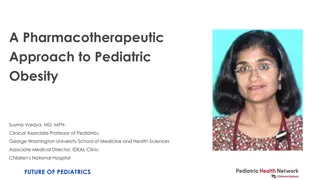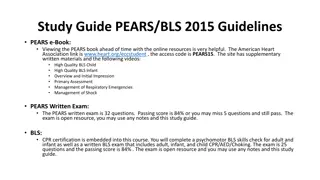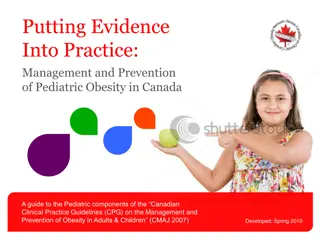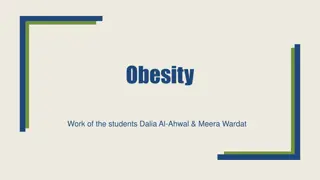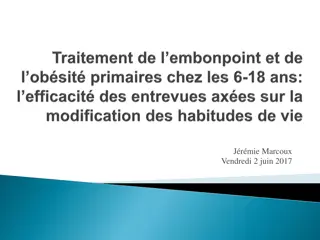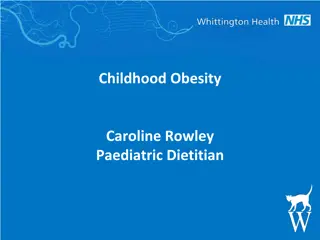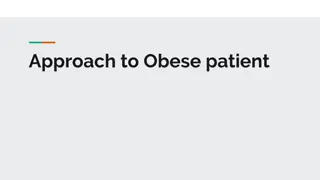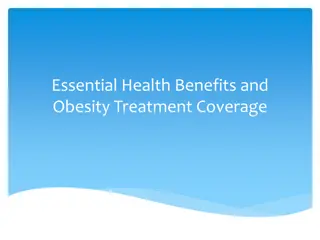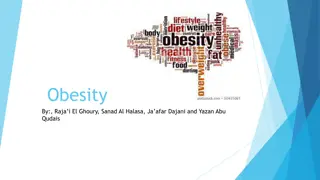Comprehensive Management of Pediatric Obesity: An Updated Approach
This presentation by Dr. Monica S. Ganatra and Dr. Greg Lessans provides an extensive overview of the management of obesity in pediatric patients. The content covers the definition of obesity, its systemic implications, pre-operative assessment, intra-operative management, and post-operative concerns. Statistics on childhood obesity trends and the impact of obesity on various organ systems are also discussed.
Download Presentation

Please find below an Image/Link to download the presentation.
The content on the website is provided AS IS for your information and personal use only. It may not be sold, licensed, or shared on other websites without obtaining consent from the author. Download presentation by click this link. If you encounter any issues during the download, it is possible that the publisher has removed the file from their server.
E N D
Presentation Transcript
Management of the Management of the Obese Pediatric Obese Pediatric Patient Patient Updated 1/2018 Monica S. Ganatra MD, MPH Assistant Professor of Anesthesiology Assistant Professor of Pediatrics Yale School of Medicine Greg Lessans MD PGY-3, Department of Anesthesiology Yale New Haven Hospital
Disclosures None
Outline Introduction Definition of Obesity Systemic Implications of Obesity Pulmonary Cardiovascular Other Organs Pre-Operative Assessment Intra-Operative Management Post-Operative Concerns Conclusion
Definition of Obesity Criteria for Diagnosis Age and gender specific cut-offs by the National Center for Health Statistics (NCHS)/Centers for Disease Control and Prevention (CDC) 2000 Growth Charts Overweight is defined as: 85th percentile < BMI < 95th percentile. Obesity is defined as: BMI > 95th percentile for children of the same age and sex World Health Organization Child Growth Standards http://www.who.int/childgrowth/standards/weight_for_height/en/ (accessed 8/1/2017)
Definition of Obesity Statistics In the US, childhood obesity has more than tripled in the past 30 years. Worldwide, the number of obese infants and young children has increased from 32 million in 1990 to is 42 million in 2013 Projected to increase to 70 million in 2025 if current trends continue Obese children become obese adults Ogden CL, Carroll MD, Curtin LR, Lamb MM, Flegal KM. Prevalence of high body mass index in US children and adolescents, 2007 2008. JAMA2010;303(3):242 9. National Center for Health Statistics. Health, United States, 2004 with Chartbook on Trends in the Health of Americans. Hyattsville, MD; 2004. Serdula MK, Ivery D, Coates RJ, Freedman DS, Williamson DF, Byers T. Do obese children become obese adults? a review of the literature. PrevMed. 1993;22(2):167-177. World Health Organization Committee on Ending Childhood Obesity. Facts and Figures on Childhood Obesity http://www.who.int/end-childhood- obesity/facts/en/ (Accessed 8/1/2017)
Implications of Obesity- Pulmonary Effect of Obesity on Lung Volumes Sood, A. and Ortiz-Cantillo. Obesity and Pulmonary Dysfunction. Figure 1. American College of Chest Physicians. PCCSU Article | 05.01.08 (http://www.chestnet.org/accp/pccsu/obesity-and-pulmonary-dysfunction?page=0,3) (accessed 12/29/10)
Implications of Obesity- Pulmonary Closing Capacity Closing volume (CV) = volume of the lung at which small dependent airways collapse Normal/healthy patient: CV is less than the Functional Reserve Capacity (FRC) so that the airways remain open during normal tidal breathing Patients with obesity, COPD have higher closing volumes, so even a small decrease in FRC can cause small dependent airway collapse
Implications of Obesity- Pulmonary Atelectasis Obese patients have decreased FRC FRC may fall below CV and lead to alveoli closure during normal tidal volumes, causing atelectasis and a V/Q mismatch V/Q mismatch during ventilation leads to hypoxemia Chronic hypoxemia leads to the inability to normalize PaCO2 http://openphysio.co.za/index.php?title=Bronchopulmonary_dyspl asia (accessCed 1/6/11)
Implications of Obesity- Pulmonary Physiology Increased metabolic rate = oxygen demand CO2 production alveolar ventilation Decreased chest wall compliance from adipose tissue over thorax Increased abdominal mass forces the diaphragm cephalad and decreases lung volumes
Implications of Obesity- Pulmonary Physiology II Pulmonary function tests consistent with restrictive lung disease work of breathing Chronic hypoxemia and chronic hypercarbia http://medstudentmom.com (accessed 12/23/10)
Implications of Obesity- Pulmonary Asthma Nearly 30% of obese children suffer from asthma Usually more severe in nature than those children of normal weight Obese infants and children are more likely to suffer from respiratory infections which can necessitate a change in the timing of elective surgery Earl S. Ford, MD, MPH The Journal of Allergy and Clinical Immunology Volume 115, Issue 5, Pages 897-909, May 2005. The epidemiology of obesity and asthma Shnur, M. and Pierece, M.E.P. Optimal outcomes for the obese pediatric patient. OR Nurse May 2010 pp. 26-33 http://familynatural.com/
Implications of Obesity- Pulmonary Asthma and Anesthesia Patients with bronchial asthma have an increased risk of developing intra-op bronchospasm, especially if they are receiving general anesthesia with an endotracheal tube http://www.fireengineering.com/index/articles/display/350276/articles/fire- engineering/volume-162/issue-1/features/capnography-a-tool-for-every-patient.html (accessed 12/28/10)
Implications of Obesity- Cardiovascular Physiology Increased cardiac output (CO) and blood volume in order to perfuse additional fat stores CO increases o.1 L/min/kg of adipose tissue CO achieved through increased stroke volume and results in arterial hypertension and LVH in pulmonary blood flow and pulmonary artery vasoconstriction from persistent hypoxia can lead to pulmonary hypertension and cor pulmonale
Implications of Obesity- Other Organs CV: hypertension, hyperlipidemia, chronic inflammation, endothelial dysfunction Pulm: Obstructive sleep apnea, asthma GI: GERD, fatty liver disease, gallstones Endocrine: Diabetes, hyperinsulinemia Zina Deretsky, National Science Foundation (http://www.nsf.gov/news/news_images.jsp?cntn_id=109781&org =NSF) (accessed 12/30/10)
Implications of Obesity- Other Organs GYN: Polycystic ovary disease, menstrual irregularities Psych: Decreased self- esteem, poor body image, depression Renal: glomerulosclerosis building-selfesteem.com (accessed 12/30/10)
Pre-Operative Concerns Based on a retrospective review of 6,094 children at the University of Michigan: Higher prevalence of medical comorbidities in overweight and obese patients Most common diseases: hypertension, diabetes, and asthma Difficult airway significantly more common in obese patients Nafiu et al. Childhood body mass index and perioperative complications. Pediatric Anesthesia. 2007 17: 426-430
Pre-Operative Assessment Pre-op Concerns Make sure child and family receive privacy Review history and medical chart, including previous anesthetic records Airway assessment, including neck evaluation Heart and lung exam Vital signs Height and weight on day of surgery imway2fat.wordpress.com (accessed 12/20/10)
Pre-Operative Assessment Airway Assessment Thorough exam is essential Look for anatomic changes such as: fleshy cheeks large tongue abundant flaps of palatal, pharyngeal, and supralaryngeal tissues related to obesity This can make tracheal intubation challenging
Pre-Operative Assessment Mallampati Score Important, but not as clear a predictor of difficult intubation as with adult patients Pediatric Emergency Medicine By Jill M. Baren, Steven G. Rothrock (C) 2008 by Saunders, an imprint of Elselvier, Philadelphia. Page 46 Image: primumn0nn0cere.wordpress.com (accessed 12/20/10
Snorlax from Pokemon http://www.dltk-kids.com/pokemon/adoptions/snorlax.html (accessed 12/30/10)
Pre-Operative Assessment Obstructive Sleep Apnea May be undiagnosed in obese children Up to 60% of obese children have symptoms of OSA Ask for symptoms: snoring, gasping for breath at night, and daytime somnolence Does your child snore? Sensitivity 91%, Specificity 75% If the answer is Yes, Signs of apnea? Sweating during sleeping? Restless sleep? Determine if patient may need to stay for 24 hour observation, pulse oximetry monitoring on floor Up to 27% of patients with OSA will have post-operative respiratory complications, depending on severity of OSA and age Children with OSA and/or extreme obesity status post T&A should be admitted for overnight observation Patients with mild-moderate obstructive disease and no comorbidities can usually be discharged same day if at least 3 years old Narang I, Mathew JL. Childhood obesity and obstructive sleep apnea. J Nutr Metab. 2012;2012:134202. Schwengel DA, Sterni LM, Tunkel DE, Heitmiller ES. Perioperative management of children with obstructive sleep apnea. Anesth Analg. 2009;109(1):60-75.
Pre-Operative Assessment Gastric Volumes Currently no recommendations to change fasting guidelines in children based on obesity alone Oral midazolam increases gastric residual volume more than oral acetaminophen Higher incidence of GERD in obese patients Cook-Sather et. al. Overweight/Obesity and Gastric Fluid Characteristics in Pediatrics Day Surgery: Implications for Fasting Guidelines and Pulmonary Aspiration Risk. Anesthesia and Analgesia. Vol 109: No. 3, Sept 2009 727-736
Pre-Operative Assessment IV Access Can be challenging in obese patients Consider using EMLA cream with sufficient time for it to work, alone or with oral midazolam Have special equipment such as transilluminator, ultrasound available
Show Me The Vein Dorsal aspect of hand: Most successful site in obese pts Volar aspect of wrist: Second most successful site: Nafiu et al. Comparing peripheral venous access between obese and normal weight children. Pediatric Anesthesia. Volume 20, Issue 2, pages 172 176, February 2010. Images: Taljanovic et al. Ultrasound of the Intrinsic and Extrinsic Wrist Ligaments and Triangular Fibrocartilage Complex Radiographics Nov 15 2010
Intra-Operative Management Pre-Oxygenation Pre-oxygenation before induction: helps offset the FRC Obese children undergoing elective noncardiac surgery had a greater incidence of: Difficult mask ventilation Airway obstruction Bronchospasm Major oxygen desaturation Setzer, n et. Al Childhood obesity and anesthetic morbidity. Pediatric Anesthesiology. 2007 17: 321-326 Tait A, Voepel-Lewis T, Burke C, et al. Incidence and risk factors for perioperative adverse respiratory events in children who are obese Anesthesiology 2008: 108 (3):375-380
Intra-Operative Management Intubation While difficult laryngoscopy is more common in obese pediatric patients, the overall incidence is still low One explanation- characteristics that are known to contribute to difficulty in adults (such as beard, thick neck, pregnancy, large breasts) are not present in children Nafiu et al. Childhood body mass index and perioperative complications. Pediatric Anesthesia. 2007 17: 426-430
Intra-Operative Management Obesity and Pharmacology Propofol: lipophilic drug; does not have increased volume of distribution in obese patients, so dose according to ideal body weight (IBW) Various methods exist to estimate IBW in children. All center on using the 50thpercentile weight based on child s age and height. Thiopental, midazolam: very lipophilic and increased volume of distribution, so dose according to total body weight (TBW) Neuromuscular blockers (such as rocuronium and vecuronium) and morphine: IBW, as obesity does not alter the pharmacokinetics and pharamacodynamics Succinylcholine and fentanyl dosages: should be based on TBW Brenn BR. Anesthesia for pediatric obesity. Anesthesiol Clin North America - 01-DEC-2005; 23(4): 745-764, Barash et al. Clinical Anesthesia page 1237, table 47-5, 6th edition (2009) Phillips S, Edlbeck A, Kirby M, Goday P. Ideal body weight in children. Nutr Clin Pract. 2007;22(2):240-5.
Calculating Ideal Body Weight (IBW) Various methods exist to estimate IBW in children. All center on using the 50thpercentile weight based on child s age and height. McLaren Method: Determines 50th percentile height-for-age and uses expected body weight for this height as child s IBW Moore Method: Determines what percentile the child s height-for-age is, and then uses the expected weight-for-age at the corresponding percentile as the child s IBW i.e., if child is 10th percentile height-for-age, then IBW would be equal to the 10th percentile weight-for age of the child. BMI Method: Multiply BMI at the 50thpercentile for child s age by the height in meters, squared. IBW = (BMI at 50th percentile) x (height in meters)2 No method has been proven superior to the others below age 8. Above age 8, recommend using adult method to calculate IBW. Phillips S, Edlbeck A, Kirby M, Goday P. Ideal body weight in children. Nutr Clin Pract. 2007;22(2):240-5.
Intra-Operative Management Positioning and Padding Take care with positioning, especially bony prominences and areas in contact with the OR table Adipose tissue: not as vascular; predisposes patients to pressure ulcers Use adequate axillary support for lateral position to prevent brachial plexus injury . thekingpin68.blogspot.com/.../michelin- man.html (accessed 12/29/30)
Prone, lateral, and semirecumbent positions are tolerated better than supine and Trendelenburg positions 1. Positioning the Morbidly Obese Patient for Surgery Jay B. Brodsky, M.D. International Society for Perioperative Care of the Obese Patient (ISPCOOP) website ispcop.org (accessed 1/2/11) 2. Image: Shoponline2011.com (accessed 1/2/11)
Intra-Operative Management Thermoregulation Maintain thermoregulation to prevent increased metabolic demands Methods to achieve this: Forced air warming blankets Fluid warmers Warm Operating Room Warming mattresses cartoonstock.com (accessed 12/28/10)
Post-Operative Concerns PACU Stay Overweight and obese children were more likely to have prolonged stay (x>3 hours) in the PACU, probably a reflection of the incidence of upper airway obstruction and the need for more than two anti-emetics Pulse oximetry and end-tidal CO2 monitoring for patients with OSA that are admitted overnight There are not current recommendations on who requires overnight observation. Generally accepted that < 3 years old with OSA should be monitored overnight For >3 years, recommend early-in-day case, several hours PACU observation and if no adverse events discharge home Nafiu et al. Childhood body mass index and perioperative complications. Pediatric Anesthesia. 2007 17: 426-430 Fung et. al Postoperative respiratory complications and recovery in obese children following adenotonsillectomy for sleep-disordered breathing: a case-control study. Al Otolaryngology Head Neck Surg. 2010 Jun;142(6):898-905
Intra-Operative Management PACU Considerations Have oral and nasal airways, resuscitation equipment readily available Teach staff to recognize and treat airway obstruction Teach staff to distinguish between laryngospasm and upper airway obstruction PONV prophylaxis with more than one drug to help shorten PACU duration
Conclusion Healthcare team members educated about special considerations for the obese pediatric patient will be better prepared to provide safe, sensitive, and knowledgeable care for these patients and their families Shnur, M. and Pierece, M.E.P. Optimal outcomes for the obese pediatric patient. OR Nurse May 2010 pp. 26-33
Select Bibliography Brenn BR. Anesthesia for Pediatric Obesity. Anesthesiol Clin North America - 01-DEC-2005; 23(4): 745-64, Cook-Sather et. al. Overweight/Obesity and Gastric Fluid Characteristics in Pediatrics Day Surgery: Implications for Fasting Guideline and Pulmonary Aspiration Risk. Anesthesia and Analgesia. Sept 2009; Vol 109: No. 3, pp. 727-736 Ogden CL, Carroll MD, Curtin LR, Lamb MM, Flegal KM. Prevalence of high body mass index in US children and adolescents, 2007 2008. JAMA 2010;303(3):242 9 Nafiu et al. Childhood body mass index and perioperative complications. Pediatric Anesthesia. 2007 ; 17: 426-430 Nafiu et al. Comparing peripheral venous access between obese and normal weight children. Pediatric Anesthesia. Feb 2010; Volume 20, Issue 2, pages 172 176, Narang I, Mathew JL. Childhood obesity and obstructive sleep apnea. J Nutr Metab. 2012;2012:134202. National Center for Health Statistics. Health, United States, 2004 with Chartbook on Trends in the Health of Americans Hyattsville, MD; 2004 Serdula MK, Ivery D, Coates RJ, Freedman DS, Williamson DF, Byers T. Do obese children become obese adults? a review of the literature. Prev Med. 1993;22(2):167-177. Setzer, n et. Al Childhood obesity and anesthetic morbidity. Pediatric Anesthesiology. 2007; 17: 321-326 Sood, A and Ortiz-Cantillo, K. Obesity and Pulmonary Dysfunction American College of Chest Physicians PCCSU Article | 05.01.08 Shnur, M. and Pierece, M.E.P. Optimal outcomes for the obese pediatric patient. OR Nurse .May 2010; pp. 26-33 Schwengel DA, Sterni LM, Tunkel DE, Heitmiller ES. Perioperative management of children with obstructive sleep apnea. Anesth Analg. 2009;109(1):60-75. Tait A, Voepel-Lewis T, Burke C, et al. Incidence and risk factors for perioperative adverse respiratory events in children who are obese Anesthesiology. 2008; 108 (3):375-380 Taljanovic et al. Ultrasound of the Intrinsic and Extrinsic Wrist Ligaments and Triangular FibrocartilageComplex Radiographics Nov 15 2010





